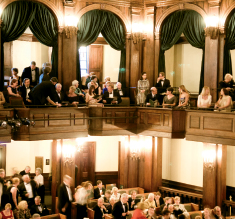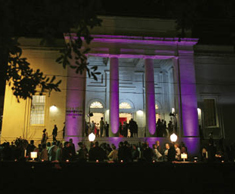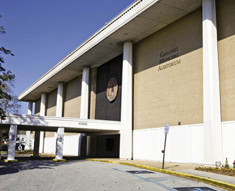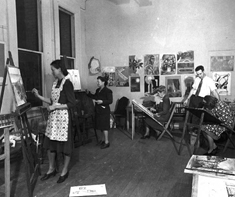
It’s a familiar scenario: an evening abuzz with the arts. The sound of an award-winning pianist soars through the Gaillard. The footlights are ablaze across town, from the Charleston Ballet and Sottile theaters to Charleston Music Hall and Theatre 99. Patrons fill the Gibbes Museum of Art for a photography exhibition, while aspiring artists attend a figure-drawing class at Redux Contemporary Art Center. Several hundred high-energy creative entrepreneurs take over the Hippodrome for the rave-like Pecha Kucha Charleston (think Toastmasters for creatives), and a few “pop-up” shows occupy empty storefronts. In total, the events have a combined capacity of approximately 6,000—roughly five percent of the peninsula’s population—dedicated to showcasing arts and culture on this particular night.
While such a lineup wouldn’t draw undue attention in May and June when balmy breezes usher in the nonstop performances associated with the Spoleto and Piccolo Spoleto arts festivals, there’s a twist. It’s a wintry, rain-streaked January night—the antithesis of those elysian spring evenings. In spite of the struggling economy, Charleston’s identity as a culture center has never been more clear. Nor has it been illustrated on this scale, a quantified increase attributed to the work of a dedicated mayor along with countless artists, administrators, and patrons, who, coupled with millions of dollars in construction, have contributed to a dynamic reenvisioning of the arts.
Address: 135 Church Street
Built: 1736; burned circa 1740; by the mid-1750s, a new theater building existed on the site. In 1809, the property became part of the new Planter’s Hotel, which closed in the 1870s.
Renovated: 1936-37 as a theater
Cost: $350,000
Current Renovation: 2007-2010
Cost: Approx. $19 million including $3.7 million from Federal Emergency Management Agency
Owned/Operated by: City of Charleston
Resident Acting Co.: Charleston Stage Co.

Although the city’s artistic past reaches back nearly 275 years—the first opera in the colonies (Flora) was performed here in 1735, and North America’s first playhouse (Dock Street Theatre) opened a year later—Charleston didn’t emerge as an artistic muse until the 1920s, when a cadre of local and visiting poets, playwrights, musicians, and painters—including Alfred Hutty, Alice Ravenel Huger Smith, and DuBose Heyward—turned their collective artistic eye to the natural beauty and curious customs of the Lowcountry. Their prolific body of work, which became known as the Charleston Renaissance (1915-1940), captivated the nation and engendered the start of our tourism industry.
But the cultural explosion was followed by a hibernation that lasted until 1977, when Spoleto Festival USA infused new energy and attention into the city. The success of this “beauty of an event,” as heralded by The New York Times in 2007, was the combined efforts of two visionaries—a 65-year-old composer by the name of Gian Carlo Menotti and Joseph P. Riley Jr., a 34-year-old politician in his second year as mayor. “I knew and loved Charleston,” says Riley, “but it took Menotti to recognize that the city’s inherent beauty was the perfect backdrop for the festival.”
Menotti, it’s told, fell for the romantic, European-opera-house design of the Dock Street and saw the slumbering but alluring city as evocative and rich as the festival he planned to produce. “A city that is an art form itself,” elaborates Spoleto trustee David Rawle. “A city large enough to have a full range of performance facilities and small enough to enable Spoleto to permeate it.”
From today’s vantage, the foundation for the festival was laid 40 years prior to Menotti’s visit, with a simple act of construction. In the 1930s, Charleston’s playhouse-cum-hotel (by then the Dock Street had evolved into The Planter’s Hotel) was a dilapidated eyesore that welcomed little more than rats. To stimulate the city’s depressed work force, two consecutive New Deal administrations—the Federal Relief and Works Progress—funded a $350,000 renovation of the theater that sparked a cultural resurrection as relevant today as it was then. “I can tell you this much,” says Riley. “Without that initial renovation of the Dock Street, there would be no Spoleto, no arts in Charleston.”
Address: 56 Beaufain Street
Built: 1939; at the time, the city’s largest performance space
Renovation Date: 2007
Cost: $6 million
Space: 10,000-square-foot “black box” space with flexible seating and staging and 1,400 feet of high-tech catwalk
Owned by: Charleston County School District
Managed by: Spoleto Festival USA

“Theater, by its nature, is always endangered,” says Spoleto general director Nigel Redden. “Tastes change, what people want to do changes, and theaters are large, expensive buildings to maintain.” When King Street’s Garden Theatre closed in 2002 and reopened as an Urban Outfitters, it was a clarion call for venue preservation heard across the city. It also thrust Spoleto into the business of theater renovation.
To prevent the loss of another venue, in 2007 Spoleto Festival USA spearheaded the $6-million overhaul of Charleston County Schools-owned Memminger Auditorium downtown, a project that required renovating the 1939 building and retooling its layout. The reconfiguration “inspired directors and designers to think about different kinds of productions, things that weren’t possible prior to the renovation,” says Redden. It was a shot in the city’s cultural arm akin to the Dock Street’s Depression-era resurrection.
And Memminger was not an anomaly. Early 2007 saw similar building projects when ground was broken for the College of Charleston’s Marion and Wayland H. Cato Jr. Center for the Arts that January and when the Dock Street Theatre’s capital improvements began that June. All the action caught the attention of native Charlestonian and businesswoman Martha Rivers Ingram, who championed a major arts facility—the $120-million Schermerhorn Symphony Center—into existence in 2006 in her adopted hometown of Nashville. “We were really in a dismal state in the early 1970s,” says Ingram, “We had no opera, professional ballet, or theater, and now all of those are flourishing with multimillion-dollar budgets.”
With the Schermerhorn Center realized, Ingram looked homeward, specifically to downtown’s Gaillard Municipal Auditorium. “A city as beautiful as Charleston deserves for this facility to be improved and made in accordance with the architecture of the surrounding area,” says Ingram, who serves on various Lowcountry boards and is chairwoman of the Spoleto Festival board.
Charleston city officials, who have been pondering the possibilities for the 1960s-era structure for some time, consulted with Ingram and hired David N. Schwarz Architects, the same Washington, D.C.-based firm that designed the Schermerhorn Center to critical acclaim. The firm is now entrenched in a pre-schematic design phase that considers the needs of local performing arts groups, traveling shows, exhibitions, and private events while balancing acoustic and structural improvements. Although the ultimate plan to overhaul the existing structure will have to win approval from city council, a $20-million matching pledge has been secured, for a total that could account for nearly half of the $100-million price tag.
Less than a mile away on Meeting Street, a venerable building co-owned by the city and the Carolina Art Association (a nonprofit founded in 1858) is also targeted for overhaul, albeit on a comparatively moderate scale. In November 2009, the city approved the $1.7 million necessary to transform the Gibbes Museum of Art back into an academy model institution, where apprentices learn from a master in an atelier setting—its original 1905 mission and configuration.
Plans will return the first floor of the Gibbes to an autonomous studio and lecture space; the existing museum store will expand to include a café; and the second and third floors will include exhibition spaces with upgraded, state-of-the-art, climate-controlled conditions that meet the American Association of Museums’ facilities standards. Gibbes director Angela Mack envisions workshops and master classes led by nationally noted artists and a curriculum that will challenge and raise the level of emerging artists. “We have a lot of young talents who flock to Charleston,” says Mack. “Unless they are challenged and pushed to continue their education to become better artists, they just flatline.”
Meanwhile, the College of Charleston, which sits on state-owned land, recently opened the Marion and Wayland H. Cato Jr. Center for the Arts, a $27-million facility that houses the Halsey Institute of Contemporary Art in addition to the School of the Arts’ rehearsal and performance space, dance and painting studios, and a photography suite. In a classic case of location, location, location, for more than a decade local awareness of the nationally renowned Halsey equaled the size of its former home in the Simons Center for the Arts—small. “Until we moved into our new space,” says director and curator Mark Sloan, “we were completely unknown, even though our exhibitions have been reviewed in national publications for 15 years.”
Today, the window-faced gallery fronts Calhoun and St. Philip streets, one block west of Marion Square, and is exposed to copious year-round foot, bike, and car traffic from locals and tourists alike. And with its 4,000 square feet—more than double its former footprint—Sloan now has the space for major, large-scale installations like this month’s “Call & Response: The Art of Nick Cave and Phyllis Galembo,” a debut collaboration between the Halsey and Spoleto.
Address: 77 Calhoun Street
Built: 1968 at a cost of $6 million
Space: The multipurpose rental facility has an auditorium with full stage, orchestra pit, and 2,726 seats; a 15,000-square-foot exhibition hall; and four meeting rooms.
Proposed Renovation: The city is reviewing plans to improve the use of performance space as well as structural elements and the acoustics.
Estimated Cost: $100 million
Owned/Operated by: City of Charleston

Just as local performance and gallery spaces are being reinvigorated, the emerging artist scene is gaining momentum as well. For young people, the educational draws are manifold: the College of Charleston boasts the state’s only undergraduate arts management degree for would-be theater company and gallery directors; the Art Institute of Charleston offers majors from fashion merchandising to the culinary arts, digital media, and on. Toss in a highly desired, destination city and the laid-back tenor of life in the Lowcountry, and Charleston is attracting an influx of creatives. “We’re the perfect example of what’s going on in America,” says Riley. “Younger people are finding themselves drawn to places that are diverse and have healthy downtowns, a good quality of life, and a variety of cultural offerings.”
Riley points to a social theory from economist Richard Florida, author of The Rise of the Creative Class and Who’s Your City?, to underscore the importance of this influx. Florida says those who create new ideas, new technology, and/or creative content as their economic function will be at the forefront of industrial growth over the next decade. Riley contends that the Lowcountry meets Florida’s three requisites for success with our highly talented, skilled population; diverse community; and digitally connected infrastructure that can support a nontraditional work force—one that might telecommute and doesn’t necessarily work 9 to 5 in a cubicle-laden, high-rise office.
In 2005, the results of a nine-month study commissioned by the Charleston Regional Development Alliance (CRDA), an economic development organization, identified five industries ripe for growth here: biosciences, aviation, automotive, high-tech security, and the creative industries. The 166-page report by AngelouEconomics specifically noted that Charleston is in a unique position to differentiate itself from other communities via the “creative cluster.”
Three years later, the CRDA and New Carolina: South Carolina’s Council on Competitiveness formed Parliament, an all-volunteer advisory committee comprised of creative sector stakeholders in the digital media, publishing, film, culinary, architecture, and visual arts arenas. To date, the organization has funded two key projects: an ongoing group called Pecha Kucha Charleston that puts innovative thinkers on stage to perform their pitches and, of critical importance to the business of the arts, the commission of a $30,000 economic impact study on Charleston’s current creative industries. “We know anecdotally there is an impact,” says Steve Warner, a business development specialist with CRDA. “This study will give us hard economic data on wages and quantity of jobs, so we can define our creative industry based on the depth we have in our community.”
The goal? Austin has music; Napa has wine; and Parliament leaders want Charleston to be known as the little creative engine that could. And if the group successfully hangs a creative moniker on the city, the ensuing business opportunities will require more space than we currently have, existing renovations included. “Charleston has so many entrepreneurs and creative types who are thinking outside the box,” explains Jessica Bluestein, executive director of Charleston Regional Alliance for the Arts (CRAA). “But they still need a ‘box’ in which to create.”
The CRAA, a group of preservation-minded patrons galvanized in the wake of the Garden Theatre’s demise, is working with developers to identify otherwise unused buildings with potential to showcase art and house administrative staff. According to founder Nella Barkley, several buildings on the peninsula are under active consideration. “These spaces would be really hard to bring up to Class A code for commercial use,” says Barkley. “However, they are not only quite feasible spaces for not-for-profits but could be made exceedingly attractive.”
Address: 135 Meeting Street
Built: 1905 with rear addition in 1978
Space: 28,000 square feet, including galleries, bookstore, and offices
Proposed Renovation: To return the first floor to studio and lecture space,
expand the museum store to include a café, and upgrade climate-control systems
Estimated Cost: $1.7 million
Owned by: City of Charleston and Carolina Arts Association

Amid the bevy of optimistic creative entrepreneurs and major donors ushering in a new age of facilities, arts organizations are exploring ways to sustain art—everything from sculptures spun of human hair to the austere refinement of classical music concerts. However, the announcement in late March that the Charleston Symphony Orchestra was suspending operations for the first time in its 75-year history was an ominous reminder that art does not exist in a vacuum.
“It’s irrefutable that although we have a growing arts community,” says Barkley, “it’s still a struggling arts community.” Managing aspects not central to the performance—proper accounting methods, strategic fundraising, and collating data collected from ticket sales—will be among the CRAA’s primary services. “Artists don’t always possess a business brain,” says Bluestein. “Helping creative people find a balance between the art and the books, without losing the integrity of the work, is where we come into play.”
The hope is that if artists and creatives can scratch out work now, it will be the prelude to a surge of work when the economy rebounds. “In the face of the current economy,” says Robert Prioleau, Parliament founding member and strategy director with local interactive branding company Blue Ion, “perhaps the one thing that can plow us forward—because people need it more than ever—is a sense of optimistic entrepreneurialism, the notion that people can scrape by and continue to produce art with a meager budget.”
At a symposium for artists and arts professionals held at the College of Charleston in February 2010, John F. Kennedy Center for the Performing Arts president Michael Kaiser cautioned his audience, saying any group that allows a recession to dictate its programming is effectively dead. He argued against the notion of slashing programming at the first sign of an economic downturn. “The counterintuitive thing and scary thing to do is think big,” he said, suggesting that arts groups work five years in advance, which allows sufficient time to cultivate underwriting. That caught the attention of Spoleto trustee Bill Medich. “If the arts groups focus on putting quality onto the stage and effectively communicate what they’re doing, which requires critical self-analysis, it will work,” says Medich.
Although stark in his assessment of the recession’s toll on the already troubled state of the arts, Kaiser repeatedly encouraged his audience to embrace their role as the community’s creative force and catalyst for energy, excitement, and renewal. “Our recession is a short-term event,” adds Riley. “The underpinnings we had before are all still there: beauty, climate, the ocean, livability, the creative nature of the downtown area—none of that has changed. Our future has never been brighter.”
Address: 161 Calhoun Street
Built: 2009
Cost: $21 million
Space: 70,000 square feet, including the Halsey Institute of Contemporary Art (3,300 square feet of exhibition space plus offices), rehearsal and performance spaces, dance and painting studios, and a photography suite
Owned/Operated by: College of Charleston School of the Arts

Amid the renewal of the area’s long-standing arts organizations, some newer groups are bringing additional energy to the arts scene:
Kulture Klash
The arts festival for the alternative crowd, Kulture Klash has been drawing edgy creative types to the Navy Yard at Noisette since the first biannual event was held in November 2007. The one-night showcase transports attendees to a big-city industrial scene, where art is on the walls as well as live and in action, with spoken word, aerial acrobatics, graffiti, and all manner of funky performances. Sadly, organizers had to cancel this spring’s installment as they search for a new venue. They hope to have one by early fall.
(843) 478-1615, www.kultureklashartsfestival.com
Outer Space
In December 2009, a group of local 20-somethings opened this community center for creative expression. Run by volunteers and funded by donations, the venue offers art shows, musical performances, and workshops, as well as a book and ’zine library. From May 6 to 31, Outer Space presents “Nothing at the Moment,” an exhibition of new paintings and hand-pulled screen prints by Karen Ann Myers, executive director of Redux Contemporary Art Center, and Tony Csavas, an adjunct professor of painting and drawing at College of Charleston. There will be an opening reception on May 6 from 6 to 9 p.m.
623-A Meeting St. www.outerspacecharleston.org
Pecha Kucha Charleston
Described as “a mix of show-and-tell, open-mic night, and happy hour,” Pecha Kucha (Japanese for chit chat) originated in Tokyo in 2003 as an event for young designers to meet and network. Currently held in more than 230 cities around the world, Pecha Kucha features presentations by creatives who show 20 images and talk for six minutes, 40 seconds. Charleston has had its own Pecha Kucha events since 2008, when Parliament Charleston—a volunteer group aiming to help the region “realize its full potential as a creative community”—started organizing the gatherings. The local events occur quarterly, and locations are announced to ticket-holders via e-mail approximately three days prior to the event. www.pechakuchacharleston.com
Redux Contemporary Art Center
Located in a 6,000-square-foot warehouse on St. Philip Street, Redux Contemporary Art Center has grown into its feet since its founding eight years ago. With a mission “to introduce new contemporary visual artists to the community,” the nonprofit creative hub presents year-round art exhibitions, lecture series, and film screenings; hosts arts classes, workshops, and special events; houses 15 artists in affordable studio spaces; and provides the only public printmaking and darkroom facilities in the city.
136 St. Philip St., (843) 722-0697, www.reduxstudios.org